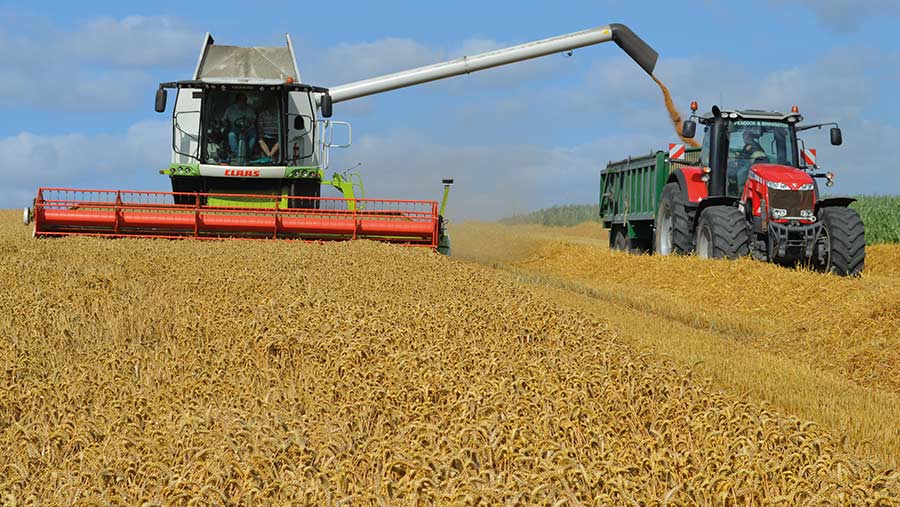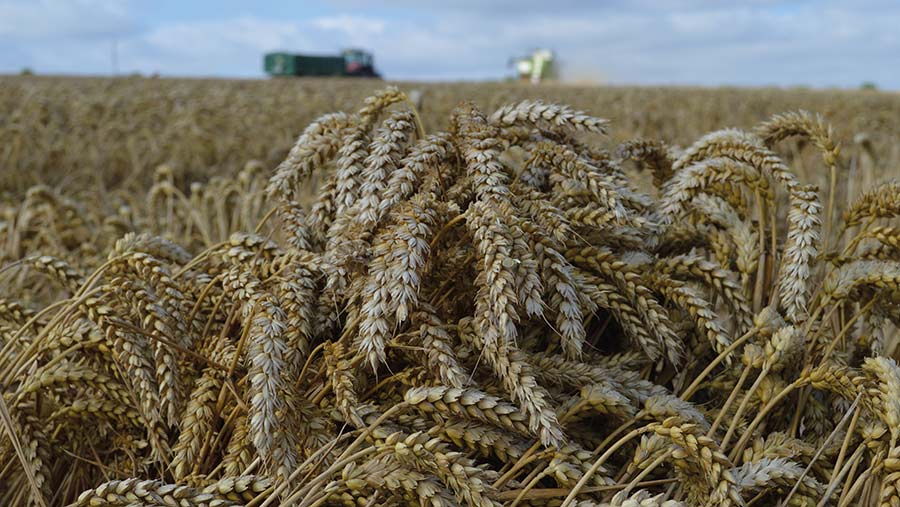How a world champion keeps his wheat free of disease
 © MAG/David Jones
© MAG/David Jones Variety choice and knowing its weaknesses is the starting point to keeping winter wheat crops clean of disease and was behind Tim Lamyman’s success in breaking the world wheat yield record with a crop of nearly 18t/ha last summer.
The Lincolnshire Wolds grower chose a wheat variety with strong septoria resistance, especially after a tough disease control year in 2021, and good yellow rust resistance, but his favoured variety Champion – which he sees as one of the best varieties grown on his farm – had only moderate resistance to brown rust.
See also: Lincs grower tightens grip on top-yields record with new win
“Champion has a slight weakness to brown rust which can come in late in the season encouraged by the sea mists we see on the farm,” he tells Farmers Weekly.

Tim and Rob Lamyman © MAG/David Jones
Backloaded programme
Therefore, his fungicide plan was to backload his programme with rust-active azoles and strobilurins at the later fungicide timings of T2 and T3 and even at a very late T4 to keep brown rust out of his award-winning crop.
On his 600ha arable farm at Worlaby on free-draining chalky loam soils high on the Lincolnshire Wolds just south of Louth, moisture-laden mists can drift in from the North Sea which is just over 10 miles away.
His world record crop of the hard-milling feed wheat variety Champion was drilled on September 24 after oilseed rape, and he says the foundation of his yield success was using the micronutrient foliar feed Delta in the autumn and early spring to create a big fibrous root system, resulting in a high-yielding crop.
Although there were some small signs of septoria on the older leaves of his wheat crop even before the T0 fungicide spray, no major disease was seen throughout the season until harvest on 10 August.
Spray costs
The cost of his five-spray fungicide programme was £150/ha, and along with a foliar feed programme costing £125-£135/ha, this was a high-input crop, but with a 17.96t/ha yield and a gross margin approaching £2,500/ha it proved to be a good investment.
The variety Champion has the third-highest septoria resistance score at 8.1 on the current AHDB Recommended List, just behind fellow DSV variety Theodore and also Mayflower.
Mr Lamyman looks for at least a 6.5 septoria score, and preferably 7 or 8, in a 1-9 range where 1 is susceptible and 9 shows good resistance.
Early in the spring, his first fungicide T0 spray in late March was of the azole tebuconazole to give protection against any early attacks of yellow rust.

© MAG/David Jones
Focus on septoria
For his T1, Mr Lamyman used the SDHI fluxapyroxad plus azole mefentrifluconazole product Revystar to give broad spread disease control with a focus on septoria, plus more tebuconazole to boost rust control.
He sees mefentrifluconazole as helping improve nitrogen fertiliser use efficiency.
At the flag leaf T2 timing, he again uses a similar SDHI-azole mix with the strobilurin pyraclostrobin added for additional brown rust control.
His T3 head spray was an azole-strobilurin mix and a very late T4 azole spray was applied to keep out late rust.
He believes many growers make the mistake of cutting back on T3s thinking the season is almost over, but his late fungicides plus his late crop nutrition programme helps keep his crops green.
“This has seen our crops show good green leaf retention with crops staying green for three to four weeks longer than our neighbours,” he says.
Crop nutrition
His fungicide programme has been aided by a comprehensive crop nutrition programme, with the nitrogen-phosphate-potassium product TipTop used at T0 and T2 to build crop biomass and again at T3 to get late phosphate into the crop as he has detected a deficiency of this mineral in previous crops.
He had used this product late in the season with success on his oilseed rape crops, and when used on wheat it produced an impressive specific weight of 83.6kg/hl from a variety which has a tendency to give low values.
As well as a very high specific weight, the variety produced an impressive 64 grains/ear, way above a more common 35-40 grains, for a crop which at harvest showed about 550 heads/sq m.
This produced a high harvest index – the ratio of grain to the whole crop biomass of between 56 and 61%, whereas normal crops would be at about 40-45%.

© MAG/David Jones
Growth regulators
He uses a “little and often” plant growth regulator (PGR) approach of three treatments, T-1, T0 and T1, with the last two tied in with fungicide applications, and the programme taking account of Champion’s only moderate straw strength.
As PGRs can cause plant stress, especially in dry conditions, the micronutrient product XStress was used at T1, T2 and T3 to try to counter any such stress in the wheat crops.
Mr Lamyman uses high doses of nitrogen fertiliser in a range of 310-350kg/ha for his record crops, but due to a dry autumn, and therefore a good level of mineralised nitrogen in the soil, his winning wheat crop received only 314kg/ha.
This was applied as three equal doses of 100kg/ha with the remaining nitrogen coming from the foliar feed treatments. Sulphur and magnesium were also applied.
Mr Lamyman’s success comes as a partnership between BASF advising on fungicide advice, Frontier on agronomy and Bionature on crop nutrition.
Fungicide and plant growth regulator programme |
|
|
T-1 (5 March) |
Moddus (trinexapac-ethyl) at 0.05 litres/ha |
| T0 (28 March) | Toledo (azole tebuconazole) at 0.15 litres/ha plus PGRs Moddus (0.05l/ha) and chlormequat (0.5 litres/ha) |
| T1 (21 April | Revystar (SDHI fluxapyroxad + azole mefentrifluconazole) at 1.2 litres/ha plus Toledo (0.15 litres/ha), plus PGRs Moddus (0.05 litres/ha) and chlormequat (0.5l/ha) |
| T2 (17 May) | Myresa (mefentrifluconazole) at 1.2 litres/ha plus Syrex (SDHI fluxapyroxad + strobilurin pyraclostrobin) at 1.2 litres/ha |
| T3 (18 June) | Proline (azole prothioconazole) at 0.55 litres/ha plus strobilurin Azofin Plus (azoxystrobin) at 0.25 litres/ha |
| T4 (2 July) | Toledo at 0.3 litres/ha |
| Note: The wheat crop also received foliar feed products Delta at T-1, Delta and TipTop at T0, Delta and XStress at T1, XStress, TipTop and CalFlux at T2 and these same three products at T3 | |
World records
At harvest 2022, Mr Lamyman broke two world records, with his Champion winter wheat crop yielding 17.96t/ha, beating the previous world record holder Eric Watson from New Zealand, who harvested a 17.40t/ha crop in February 2002.
Mr Lamyman also broke his own world record for winter barley with a crop of the variety Tardis yielding 16.21t/ha compared with his 2021 record of 14.20t/ha.
His resulting yields were more than twice the UK average in 2022, which were 8.6t/ha for winter wheat and 7.4t/ha for winter barley.
In addition, he harvested a very high gross output yield of 8.98t/ha for oilseed rape, with a variety mix of Acacia and Attica, which would have been a world record, but it was only grown across 2ha and world record attempts need to be across at least 8ha.
Again, the yield was well above the UK 2022 average yield of 3.7t/ha.

